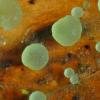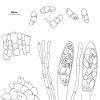
15-12-2025 07:09
 Danny Newman
Danny Newman
indet. Rutstroemiaceae sp. on unk. fallen leavesMc

15-12-2025 21:11
 Hardware Tony
Hardware Tony
Small clavate hairs, negative croziers and IKI bb

15-12-2025 15:54
 Johan Boonefaes
Johan Boonefaes
Unknown anamorph found on the ground in coastal sa

15-12-2025 15:48
 Danny Newman
Danny Newman
Melanospora cf. lagenaria on old, rotting, fallen

15-12-2025 07:05
 Danny Newman
Danny Newman
Pseudosclerococcum golindoi (det: Zotto)near Cosb

15-12-2025 11:49
 Danny Newman
Danny Newman
ITS sequences from the following two collections B

15-12-2025 12:34
 Danny Newman
Danny Newman
indet. Rhytismataceae on oak leafnear Purchase Roa

09-12-2025 12:06
 Andgelo Mombert
Andgelo Mombert
Bonjour,Je recherche l'article concernant Hypobryo
Asco on Heracleum
Nick Aplin,
29-01-2013 22:25
I have been struggling with this little ascomycete found last week on dead Heracleum stems just above snow-level in the South of England:
Apothecia sessile to subsessile, to 0.3mm. Yellowing with age
Spores 12 - 15.1 x 4.5 - 6.1 µm mainly 1-septate in the asci, finally 2-septate at maturity
Asci tips with no reaction to iodine
Croziers present
Thank you for your ideas,
Nick
Hans-Otto Baral,
29-01-2013 23:05

Re : Asco on Heracleum
The colour looks greenish on my screen,but is it perhaps whitish in reality? It is not sure that the spores are 1-septate at maturity, I suspect they are ejected aseptate, because the ascus with septate spores has a strong apical thickeing, so this ascus is surely dead.
The excipulum sketsch shows flanks and margin? Does not look like Parorbiliopsis. No idea.
Zotto
The excipulum sketsch shows flanks and margin? Does not look like Parorbiliopsis. No idea.
Zotto
Nick Aplin,
30-01-2013 01:30
Re : Asco on Heracleum
Hi Zotto,
Thanks for your thoughts.
Yes the apothecia were whitish.
Thats interesting - It makes sense that some of the asci were dead - I kept the fungus alive for a couple of days before illustrating it.
I saw very few (none?) aseptate spores outside of the asci unless I squashed the preparation under the coverslip.
It reminded me of images I have seen of Allophyllaria, but that can't be correct with a negative iodine reaction, right?
Nick
Thanks for your thoughts.
Yes the apothecia were whitish.
Thats interesting - It makes sense that some of the asci were dead - I kept the fungus alive for a couple of days before illustrating it.
I saw very few (none?) aseptate spores outside of the asci unless I squashed the preparation under the coverslip.
It reminded me of images I have seen of Allophyllaria, but that can't be correct with a negative iodine reaction, right?
Nick
Hans-Otto Baral,
30-01-2013 08:12

Re : Asco on Heracleum
Allophylaria has a thick-walled excipulum (+/- oblita), of elongat cells. Yours seem thin-walled and +/- isodiametric.
But Allophylaria is usually deep red (hemiamyloid), thoughrarely inamyoid.
But Allophylaria is usually deep red (hemiamyloid), thoughrarely inamyoid.

